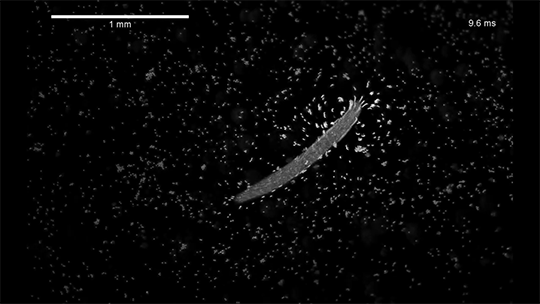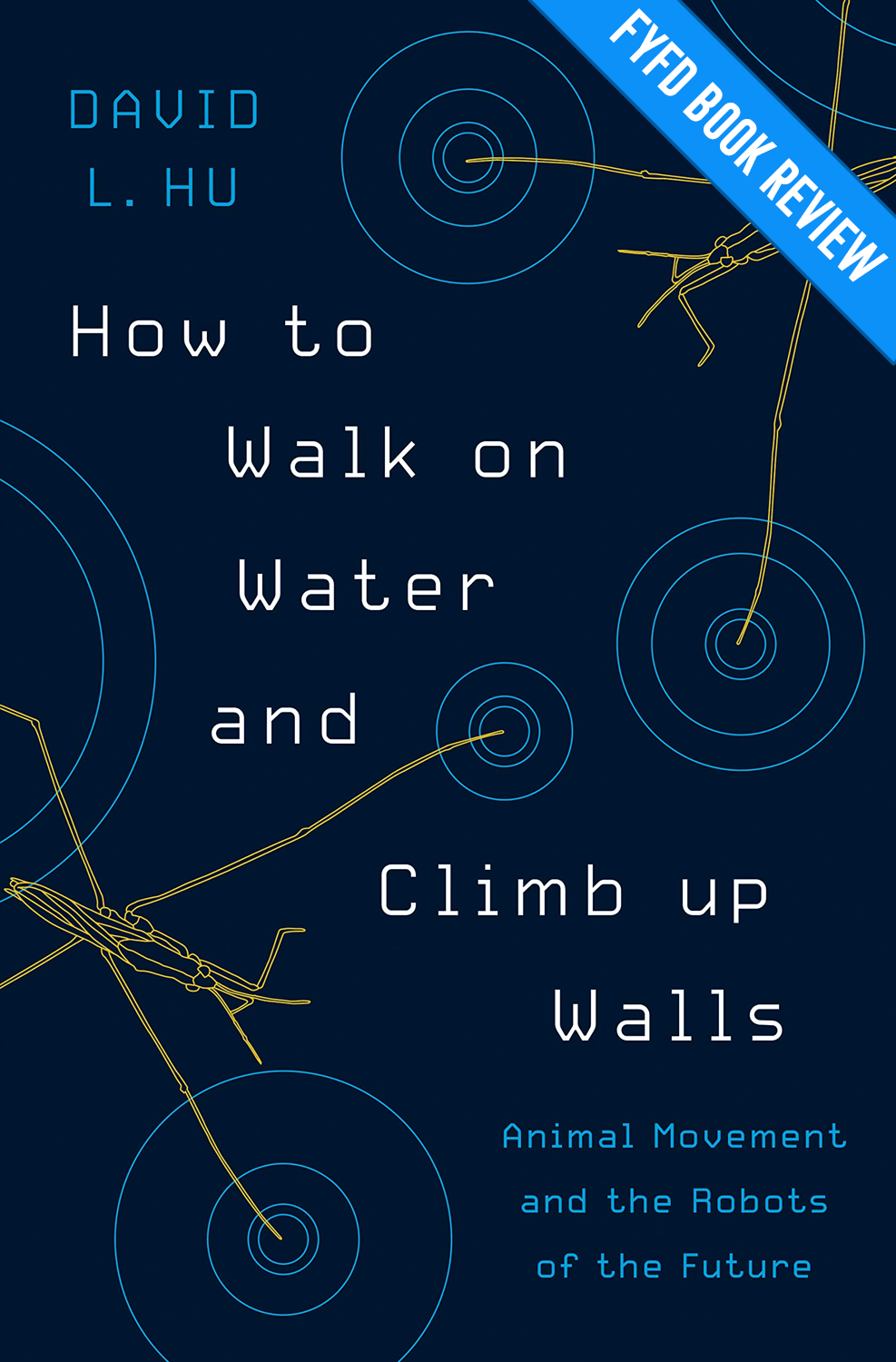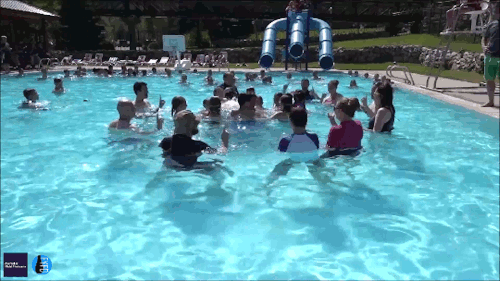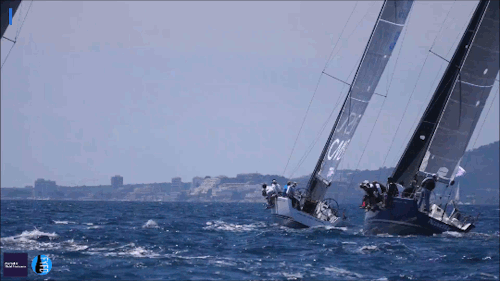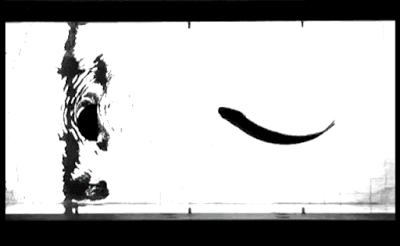When studying modern birds it quickly becomes apparent that they can either be good at swimming or at flying, but not at both. The characteristics that make wings good for flying are diametrically opposed to those that make for a good swimmer. So most species have chosen to invest in one strategy or the other. Penguin ancestors chose the swimming route tens of millions of years ago, in the aftermath of the extinction event that emptied our oceans of the large reptilian predators that had ruled them during the age of the dinosaurs. This video explores what we know about the fossil record of these birds, and it’s pretty incredible. Did you know there used to be 2-meter-tall penguins? (Image and video credit: PBS Eons)
Tag: swimming

Communication Between Microswimmers
The elongated cells of Spirostomum ambiguum swim using hair-like cilia, but when threatened, the cells contract violently, sending out long-range hydrodynamic waves, like those visualized above. Along with these waves, the cells release toxins aimed at whatever predator threatens them. In a colony, these waves act like a communication beacon. The swirl of a previous cell’s reaction tugs on its neighbors. As they contract, the message–and the toxins–spread. If the colony density is high enough, the hydrodynamic trigger waves will propagate through the entire colony, releasing enough toxins to disable even large predators. (Image and video credit: A. Mathijssen et al.)

Reducing Viscosity With Bacteria
Conventional wisdom – and the Second Law of Thermodynamics – require all fluids to have viscosity, with the noted and bizarre exception of superfluids, which can flow with zero viscosity. In essence, you cannot have work (i.e. flow) for free. Some effort has to be lost to resistance.
But scientists have discovered, bizarrely, that adding bacteria to water can result in zero or even negative viscosities – meaning that effort is required to keep the flow from accelerating. Before you ask, no, this is not a recipe for a perpetual motion machine. What happens when the bacteria-filled fluid is sheared is that the bacteria align and start collectively swimming. The local effects of each bacteria combine en masse to create a fluid that seemingly flows on its own. In the end, though, it’s the bacteria that are supplying that work. It certainly raises interesting prospects, though, for harnessing the power of bacterial superfluids. See the links below for more. (Image credit: M. Copeland, source; research credit: S. Guo et al., A. Loisy et al.; via Quanta; submitted by Kam-Yung Soh)

Swimming, Cycling, and Sailing
Summer brings with it lots of great sports, and whether you love riding a bike, sailing a boat, or just hanging out at the pool, our latest FYFD/JFM video has something for you. Want even more sports physics? Check out the Olympic series we did for the London and Rio games. And if you’re looking for more of the latest fluids research, don’t miss the rest of our video series. (Video and image credit: N. Sharp and T. Crawford)

The Swimming of a Dead Fish
When I was a child, my father would take me trout fishing, and I spent hours marveling from the riverbank at the trouts’ ability to, seemingly effortlessly, hold their position in the fast-moving water. As it turns out, those trout really were swimming effortlessly, in a manner demonstrated above. The fish you see here swimming behind the obstacle is dead. There’s nothing powering it, except the energy its flexible body can extract from the flow around it.
The obstacle sheds a wake of alternating vortices into the flow, and when the fish is properly positioned in that wake, the vortices themselves flex the fish’s body such that its head and its tail point in different directions. Under just the right conditions, there’s actually a resonance between the vortices and the fish’s body that generates enough thrust to overcome the fish’s drag. This means the fish can actually swim upstream without expending any energy of its own! The researchers came across this entirely by accident, and one of the questions that remains is how the trout is able to sense its surroundings well enough to intentionally take advantage of the effect. (Image and research credit: D. Beal et al.; via PhysicsBuzz; submitted by Kam-Yung Soh)

Leaping Mobulas
Mobula rays are second only to manta rays in size, and, unlike their larger cousins, relatively little is known about them. Like other rays, they propel themselves by flapping their large pectoral fins, and they generate thrust through hydrodynamic lift. They’re quite efficient swimmers, able to generate enough thrust to leap over 2 meters out of the water before flopping back into it. Why the mobula rays jump and why they seem to prefer belly-flopping is unclear. They may be using the slap and splash to communicate with one another. When aggregations of mobulas are observed from overhead, jumping seems to occur along the outside of the group. Maybe this is an effort to attract more mobulas to a group or a method of scaring prey into the midst of the hunting mobulas. In any case, it is spectacular to behold firsthand. (Image credit: BBC; source)

Building Smart Swimmers
Scientists have long wondered whether the schooling of fish is driven by hydrodynamic benefits, but the complexity of their environment makes unraveling this complex motion difficult. A recent study uses a different tactic, combining direct numerical simulation of the fluid dynamics with techniques from artificial intelligence and machine learning to build and train autonomous, smart swimmers.
The authors use a technique called deep reinforcement learning to train the swimmers. Essentially, the swimmer being trained is able to observe a few variables, like its relative position to the lead swimmer and what its own last several actions have been – similar to the observations a real fish could make. During training, the lead swimmer keeps a steady pace and position, and the follower, through trial and error, learns how to follow the leader in such a way that it maximizes its reward. That reward is set by the researchers; in this case, one set of fish was rewarded for keeping a set distance from their leader, one intended to keep them in a position that was usually beneficial hydrodynamically. Another set of fish was rewarded for finding the most energy-efficient method for following.
Once trained, the smart swimmers were set loose behind a leader able to make random decisions. Above you can see the efficiency-seeker chasing this leader. Impressively, even though this smart swimmer had the option to go it alone (and had never followed such a dynamic leader), it does an excellent job of keeping to the leader’s wake. Compare it with real swimmers and there’s a definite similarity in their behavior, which suggests the technique may be capturing some of an actual fish’s intuition. (Image and research credit: S. Verma et al., source; thanks to Mark W. for assistance)

The Many Shapes of Fish
After visiting an aquarium or snorkeling near a reef, you may have wondered why fish come in so many different shapes. Given that all fish species need to get around underwater, why are some fish, like tuna, incredibly streamlined while others, like the box fish, are so, well, boxy? There are several major groupings for fish based on their shape and how they propel themselves, whether it’s by undulating their body and tail or primarily by flapping their fins. Which grouping a fish tends toward depends largely on its environment and needs. Open-water swimmers tend to use their bodies and tails. Their bodies are better streamlined, too, allowing them to outrace even some ships! Fish that live in more complicated environments, like along the seafloor or in a reef, tend to favor maneuverability over speed. These fish – which include rays, pufferfish, and surgeonfish – use their fins for their main propulsion. Many of these species are still faster swimmers than you or I, but their slower speeds have reduced their need for hydrodynamic streamlining, allowing these fish to evolve a wide variety of odd body shapes. (Video credit: TED-Ed)

Can Zooplankton Mix Oceans?
Krill and other tiny marine zooplankton make daily migrations to and from the ocean surface. Previously, models of ocean mixing ignored these migrations; these animals are tiny, researchers argued, so any effects they could have would be too small to matter. But zooplankton make these migrations in huge swarms, and studies of a laboratory analog of their migrations (using brine shrimp rather than krill) reveal that, when moving en masse, these tiny swimmers create turbulent jets and eddies far larger than an individual. Their collective motion is enough to mix salty water layers 1000 times faster than molecular diffusion alone! Learn more in the latest FYFD video, embedded below. (Image and video credit: N. Sharp; research credit: I. Houghton et al.; h/t to Kam-Yung Soh)




